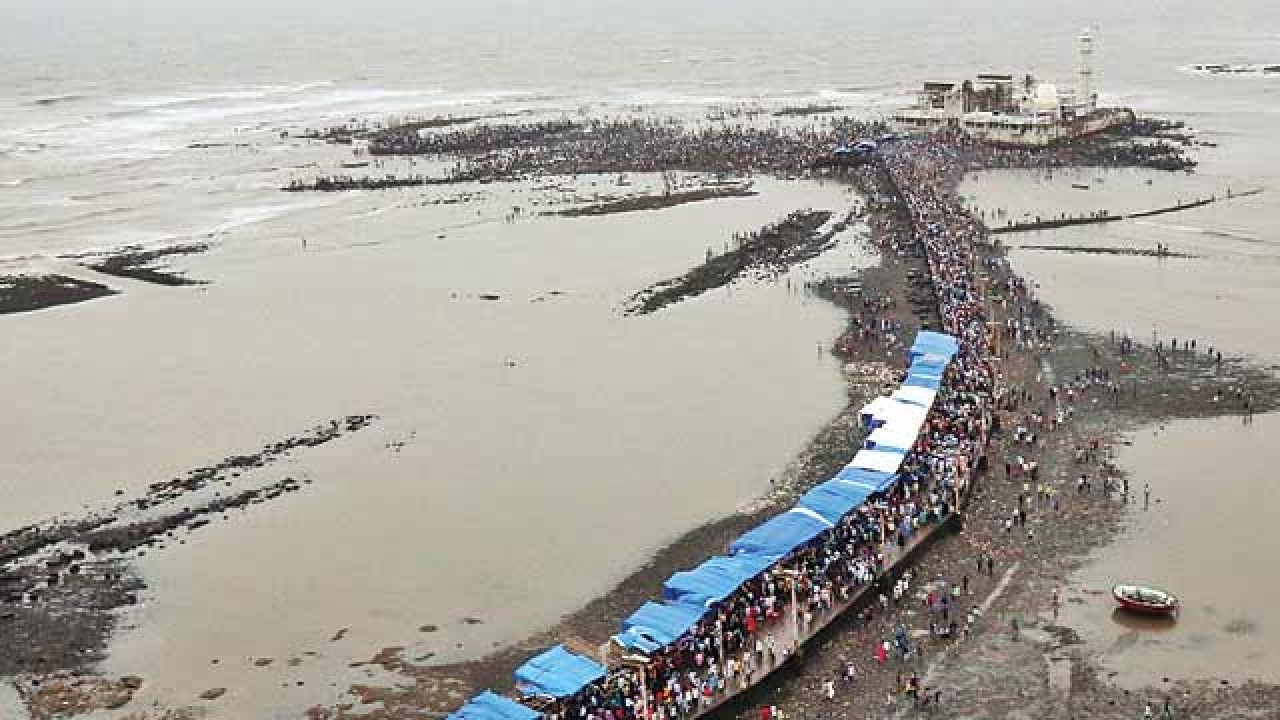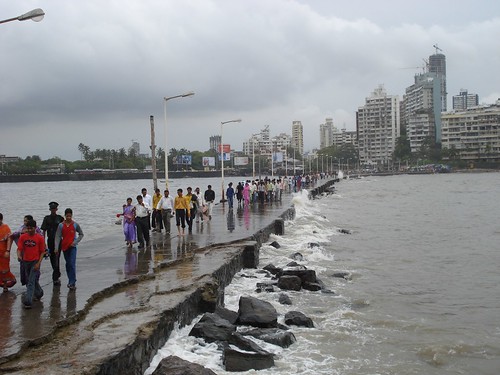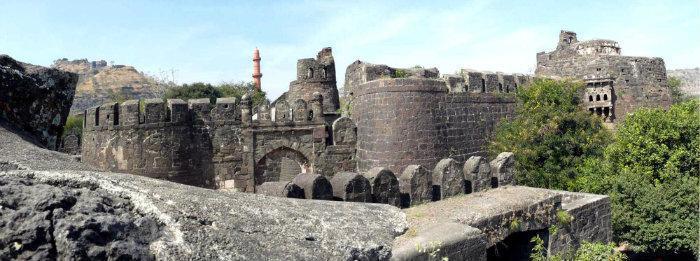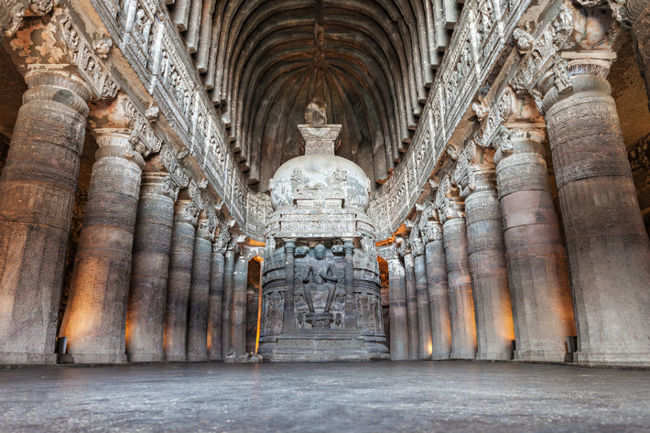KERALA State
Kerala State (pop. 35 million) is on the south-west corner of India. It is one of the more popular tourist destinations because of its great white sand beaches, general beauty (coconut groves, rice paddies, the famous backwaters) and its laid back vibe. The mountainous Western Ghats rise in the east and have spice and tea plantations, and national parks with wild elephants. In 1957, Kerala was the first place in the world to freely elect a Communist government and it is the most socially advanced state in India. It’s literacy rate is 91% and its health statistics surpass the rest of the country. However it relies heavily on tourism with little industrial development.
Bypassing the popular beach resort of Kovalem, I took a 2 hour train to Trivandrum (900,000), the capital of Kerala, and continued my city-a-day tour. I only visited the Sri Padmanabhaswamy Temple, with its 30 m high, 7 tiered gateway tower. In the inner sanctum, closed to non-Hindus, the reclining Panmanabha reclines on a serpent made from 10,000 stones brought by elephant from Nepal. The 6 m long solid gold statue makes the richest temple in the world.
The famous Indian Coffee House consists of an ascending spiral corridor with tables on the side, a la the Guggenheim in New York. The waiters are dressed in fantastic white outfits with peacock styled headdresses. It was then north to Alleppey, the gateway to the backwaters, but there were no day trips so I left early the next morning for Fort Cochin in Kochi (pop. 1.6 million), another big backpacker haven. The Backwaters consist of a network of canals visited by houseboat (expensive) or day trips. The full day trip consisted of a long drive, several hours on a houseboat with 27 other tourists and then a canoe ride through a narrow canal. A few villages are visited and I found the whole experience underwhelming. What is all the fuss about?
Mantancherry Palace, built in the 1550’s, is known for its fantastic Hindu murals with scenes from the ancient Hindu texts.
The 400-year-old synagogue in Jew Town has a gold pulpit. Enormous, cantilevered Chinese fishing nets require at least 4 people to operate at high tide. Built in 1503, St Francis Church once contained Vasco de Gama’s remains but they have now been returned to Lisbon, but his tombstone remains.
Northern Kerala has many more beach resorts but I elected to escape the heat to go to the most famous hill station in south India, Ooty (actually just inside Tamil Nadu). After a day train ride and a bus that snaked up the steep hillsides through many hair pin turns, the moderate temperatures were a welcome relief. Known for its tea plantations and day walks that require guides, I chose to do nothing for 3 days but read. It was a much-needed rest after the hectic week I had just put in.
KARNATAKA State
Heading north I took the 4-hour bus to Mysore (pop. 800,000) in the south of Karnataka State (pop. 62 million). We passed through a dry, arid environment with dry beige grass and trees in several national parks before descending to the city at 707 m elevation. With a 600-year-old heritage, Mysore is famous for silk, sandalwood and incense manufacture. All the tuk-tuk drivers sell drugs so I visited several ‘coffee houses’ to sample the merchandise. The marijuana is a poor bud with a lot of stems and most of the hash looked like cow manure – I didn’t buy any. One funny tuk-tuk drive gave his spiel offering drugs and added at the end “Jiggy jiggy?”.
At a height of 1062 m, Chamundi Hill has on its summit the Sri Chamundeswari Temple with its towering 40 m high entrance gateway and magnificent views of all of Mysore. Among the grandest royal palaces in India, Maharaja’s Palace is a fantastic former seat of the Wodeyar Maharajas. The old palace was gutted by fire in 1897, and the present building was built by the British in 1913. The interior is a kaleidoscope of stained glass, mirrors and over-the-top, gaudy interiors. The decor is further embellished by spectacular carved wooden doors, mosaic marble floors and paintings of the British Raj. Nearly 100,000 light bulbs illuminate the palace at night on weekends.
Davaraja Market, Jayachamarajenda Art Gallery, and the poor Rail Museum were also visited. Before catching the bus that afternoon, I took the 1-hour bus to Swirangapatnam, a fort town, the seat of Hyder Ali and Tipu Sultan’s empire. Tipu Sultan was killed by the British in 1799 and some of the battlements and gates of the great fort still stand. The star attraction is Tipu’s Summer Palace. Built largely of wood, the palace is known for its lavish decoration covering every inch of the interior. About 2 km east is the impressive onion domed Gumbaz where Tipu Sultan and his family are buried. The mausoleum is supported by 36 black granite columns and has a stunning tiger paint scheme.
It was then a 3-hour bus ride east to Bangalore (pop. 6 million), the hub of India’s booming software industry. With few good sites, I was using it as a transport hub to catch the night train 11 hours north to Hampi, a major pit stop on the traveller circuit. All the ruins here count as one World Heritage Site. Between 1300 – 1550, it grew into one of the largest Hindu empires in Indian history with 500,000 people. Ruins cover the unearthly landscape created by millions of years of volcanic activity and erosion. Heaps of giant boulders perch precariously over miles of undulating terrain, their rusty hues offset by green palm groves, banana plantations and paddy fields. The major travellers’ ghetto is Hampi Bazaar, a small village crammed with budget lodges, shops and restaurants, all towered over by the majestic 50 m high Virupaksha Temple. It was a feast day on arrival and lineups were huge but two days later, I entered to see another typical Hindu temple, but with a temple elephant. A pair of bullocks pulling carts are the common method of hauling freight. My first full day was overly energetic with a hot 20 km walk to see most of the sites. I initially passed two temples with huge stone Ganeshes to reach the Royal Center with beautiful polygonal stone walls almost as good as Inca walls. Highlights were the Elephant Stables, underground Shiva Temple and Queen’s Bath. The Archaeological Museum had an interesting large floor model of the entire area. The Hampi area is littered with temples composed of many one-piece, granite columns supporting massive stone roofs drained by curved stone eves. All the columns are intricately carved. It was a long walk down to the Vittala Temple, the undisputed highlight of the Hampi ruins. The showpiece is the ornate stone chariot that stands in the temple courtyard. The solid granite columns have some of the most ornate carvings in India. I met a French woman my age and it was nice to hang out with someone for a few days. On day 2, we crossed the river on a coracle, a small round reed boat paddled by a hard-bargaining kid. The crossing was next to an ancient stone bridge now evidenced by hundreds of granite pillars, three across, that once supported a stone roadway. It was then a gorgeous walk from the Ranganatha Temple through the rice paddies and banana trees to the whitewashed Hanuman Temple, accessible by a 537 step climb to the top of Anjanadri Hill and majestic views of the entire countryside. The common method of freight hauling is a pair of bullocks.
We then rented a taxi for the day to see several sites north of Hampi. Aihole has some 100 temples built between the 5th and 6th centuries with the Durga Temple the highlight. Pattadakal is a World Heritage Site with 7th and 8th-century temples. One had columns intricately carved with episodes from the Ramayana and Mahabharata. A giant black granite carving of Nandi (Shiva’s vehicle) sits in the complex. These first two sites were the beginning of South Indian temple architecture and represented stages in that evolution. Badami, the eventual capital of the Chalukya kings, has magnificent rock-cut temples, the only reason to come to this scruffy town. Four caves dedicated to Shiva and Buddha have intricate carvings of Hindu deities. A monkey almost attacked me for my water bottle and his big teeth were quite threatening. After 1 1/2 months, my third Kindle died and I ordered a new one on warranty to be delivered to Mumbai.
Bathrooms in Indian hotels are interesting. All are ‘wet’ and thus have no shower curtain. Hot water is variable. The guest house in Hampi had the most unusual setup. There were two shower heads, one cold and the other scalding hot. The spray was supposed to mix but it didn’t quite happen that way. I burnt my scalp and finally settled for the cold shower instead. The drain from the sink often goes directly onto the floor to drain into the floor drain for the shower. Here, the water moved under your feet to get to the drain and you stood on the dirty water from tooth brushing and shaving. Most bathrooms have had proper flush toilets and squat toilets are not as common as I initially thought.
GOA State
I took my first sleeper bus 11 hours west to Goa. With no seats and 32 full length beds, I anticipated a nice sleep but the unbelievably rough road made it like a carnival ride. With an area of only 3701 square kms and 1.5 million people, tiny Goa attracts over 2 million tourists a year. After a succession of rulers, the Portuguese arrived in 1510, enticed by wide natural harbours and wide waterways. Christianity was introduced and India did not acquire control of the state till 1961. Today Goa has one of India’s highest incomes, health and literacy rates. Yoga, alternative therapies, and beach life dominate the scene. The Arabian Sea, with its strong currents and dangerous undertow, makes swimming dangerous and the lifeguards don’t allow swimmers to go far from shore.
Divided into South (quieter beaches), Central (cultural area with Portuguese houses and cathedrals), and North (where all the beach action is with shopping and a fabled party scene), my bus ride ended in Panaji (pop 100,000), the state capital in central Goa. Arriving in the early AM, I spent the day in Old Goa, the original capital. Between the 16th and 18th centuries, it had a population larger than Lisbon or London and was known as the ‘Rome of the East’. The sites were several Catholic churches – Se Cathedral is the largest cathedral in Asia, the Church of St Francis of Assisi (gilded and carved woodwork), Museum of Christian Art, and Basilica of Bom Jesus (the last resting place of Goa’s patron saint, St Francis Xavier, whose body is visible through the glass-sided coffin). I missed a few other Christian sites, returned to Panaji, visited the Church of Our Lady of the Immaculate Conception and stayed in an expensive but dirty hotel room. If I were to return here, I would skip all this part of Goa and simply go to the north.
Up early the next AM, I took the local buses (no Westerners seem to ride these but they are unbelievably cheap and quite efficient at moving a lot of people) to go to Arambol, one of the major beach scenes in India. Since the 1960s, this has been the mellow paradise for hippy travellers but has now been taken over by a huge flood of Russians. A narrow street lined by stalls selling the usual tourist stuff leads down to the big, lovely beach. Small hotels and restaurants line the crescent of sand and extend well around the rocky point to the north to a second smaller quieter beach. Prices are competitive for the huge number of budget hotels, clothes and marijuana. Hippies with dreadlocks and long hair, shaved heads, tattoos, and leathered skin mingle with Russians – all seem to ride motorcycles. Baggy pants and other faux Indian clothes are the norm.
MUMBAI
I took another overnight sleeper bus 10 hours north to Mumbai, this time on smooth roads. The bed was for shorter people. Mumbai (pop 20 million) was originally 7 islands inhabited since the 2nd century BC. Controlled by Hindu dynasties from the 6th century, then Muslims in the 14th, the Portuguese took over in 1534 and the British in 1663 (leased by the British East India Company for 10 pounds/year). It flourished as a trading port and by the 1700’s, all the islands were joined as a single land mass. Massive buildings in the 1800s transformed the city in a grand colonial style. Wealth grew with the export of cotton to Britain in the American Civil War. It was the centre of the Indian independence movement. The name – Bombay was changed to Mumbai in 1996.
I stayed in a cheap hotel near Victoria Terminus in the Fort area of the city, sharing a 2-bed dorm room with a pleasant Indian man. My third Kindle arrived an hour after I arrived. The next morning, I elbowed the face of the Kindle getting out of bed and cracked the screen – there goes Kindle #4. I ordered a new one to be delivered to Ahmedabad, mailed back the old one for a free warranty replacement, and promised to treat my next one with kid gloves. I had 4 days of sightseeing planned hoping to see many of the places routinely mentioned in Shantaram, the hugely popular book centred on Mumbai. Victoria Terminus is the city’s most extravagant Gothic building and the heart of its railway network. A mixture of Victorian, Hindu and Islamic styles, it is full of buttresses, domes, turrets, spires and stained glass. Completed in 1887, it is the busiest train station in Asia and was added to the World Heritage list in 2004. I went on the walking tour suggested in Lonely Planet passing by a mix of colonial and Art Deco architecture. Oval Maidan was once on the shore of the ocean but that is now several hundred meters to the west. Some of the sites near it are the Ragabai Clock Tower, Eros Cinema (wedding cake tower), University of Mumbai (closed to outside visitors since the 2008 terrorist attack), High Court (elegant 1848 neo-Gothic building where one can go in and sit and watch any court), Flora Fountain, St Thomas Cathedral (full of interesting colonial memorials), Elphinstone College, and the Prince of Wales Museum (now called the Chhatrapati Shivaji Maharaj Vastu Sangrahalaya translation: ‘King Shivaji museum’, abbreviated CSMVS, had a good Egyptian mummy exhibit in a spectacular building). I took a wrong turn and ended up in a slum on the ocean but eventually made my way back to the Taj Mahal Palace Hotel, which was taken over in the 2008 terrorist attack. Built in 1903 by Tata, the industrialist, after being refused entry to one of the European hotels for being ‘a native’, rooms start at $400/night, were renovated after the terrorist attacks and reopened in 2010. It is opulent inside and I wandered through all the ground floor areas. Sitting on the water, it presents as a big 7-story block and is one of Mumbai’s most enduring symbols. Right next to it is the Gateway of India built to commemorate the 1911 visit of King George V. The huge basalt arch of colonial architecture sits right at the point of the city and is a top spot for people-watching. I finished out the day with a visit to Leopold’s Cafe, made famous in Shantaram. My front bridge came unglued so I went to a dentist near the hotel. He started his practice 50 years ago and his office looked it. The equipment could have been in a museum and his methods and manner belied his age. With no assistance, he didn’t bother removing the excess cement and said that it would fall out on its own.
Metal detectors are very common in India, especially since the 2008 tourist attack in Mumbai. They are at the entrance to malls, palaces, and some temples and there were banks of them at all the entrances to Victoria Terminus. I have never seen anyone respond to a positive metal detector and even if they flash green, one is still frisked. There are usually separate ones for men and women where a woman would do the frisking. Indians love to frisk you and thoroughly check all your pockets and check your bags. Often your bag must still go through an X-ray screening. It is all part of the ridiculous red tape that one must go through travelling in India. The worst is when you check into a hotel. First, there is a large ledger book for the hotel where one enters your full name, full home address, the number, date of issue, date of expiry and city where issued your passport, Indian Visa and territory permit, where you just came from, your next destination, number of days staying in the hotel and finally your signature. This is then all repeated on a police form that is done in triplicate (this form also has a place for a passport photo but this is not asked for). The hotel then makes a photocopy of your passport, India Visa and territory permit. If you make a mistake, then it all has to be done over. The hotel carefully goes over the info you have entered to ensure accuracy. Apparently, the police check regularly to ensure that the hotel has all this correct. India must have warehouses for all the ledger books and paper that is produced by this cumbersome process. Crazy.
One day I took the ancient metro one hour north (20 cents), to the World Vipassana Pagoda on Gorai Island accessible by ferry. The breathtaking structure is a 96 m high stupa with a dome designed to hold 8000 mediators. Built entirely without supports using an ancient technique of interlocking stones, it is the world’s largest unsupported dome. Along with at least 200 other centers around the world, it offers 10 day meditation courses (my daughter Rory has done this several times), where one does not speak for the duration. Riding the metro back, I stopped at Mahalaxmi Dhobi Ghat, an entire hamlet that is Mumbai’s oldest and biggest human-powered washing machine. Hundreds of people beat the dirt out of most of the city’s wash in 1026 open air troughs.
I then walked past a racecourse and golf course to Haji Ali’s Mosque, an exquisite Indo-Islamic shrine. It contains the tomb of the Muslim saint Haji – legend has it that Haji Ali died while on a pilgrimage to Mecca and his casket miraculously floated back to this spot. A long causeway out into the Arabian Sea gives access to the mosque but is under water at high tide.
It was then a long walk south to Chowpatty Beach with its deep beach bordering the toxic water.
My most fascinating day was spent on a visit to Dharavi Slum, the largest slum in India (and Asia for that matter), and the home of Slumdog Millionaire.

It incorporates 1.75 square kilometres and is home to one million people. I was all alone on the tour with Abdul, a 20-year-old Muslim kid who lives in the slum and gives a very realistic tour. Looking chaotic from the outside, it is a maze of muddy, dusty alleys and sewer lined streets with 60% Hindu, and 35% Muslim inhabitants. Home to many tiny factories, the major activity is plastic recycling. The streets and roofs are covered in huge bags of plastic which is dismantled, separated by colour, broken into tiny plastic chips, melted and formed into uniform pellets for recirculation. There are factories for leather tanning, pottery, clothes manufacturing, computerized embroidery, and aluminum electrical boxes, with an annual turnover of $665 million.
Residents pay rent, most houses have electricity (provided by a maze of electrical wires tacked to the walls), and building materials range from flimsy corrugated metal shacks to permanent multi-story concrete structures.
I visited one home, the bottom level where the 5 member family lived in a 10×5 foot space, and the top levels rented out for income. This home was worth a surprising $20,000. An incredibly foul creek filled with garbage and sewage flowed through the area.
The favelas of Rio looked nice compared to Dharavi. At least 55% of Mumbai citizens live in shantytowns and slums. Across the street from my hotel was a family who had set up a home on the sidewalk under a blue tarpaulin. They cooked on a wood fire built on the street. A haircut – neck, ears, and eyebrow trim – on a stool on the sidewalk cost 60 cents, a much better deal than the $20 it costs at home.
On my last day here, I visited Elephanta Island, a 9 km ferry ride out to the middle of Mumbai harbour. The rock-cut temples are a Unesco World Heritage Site.
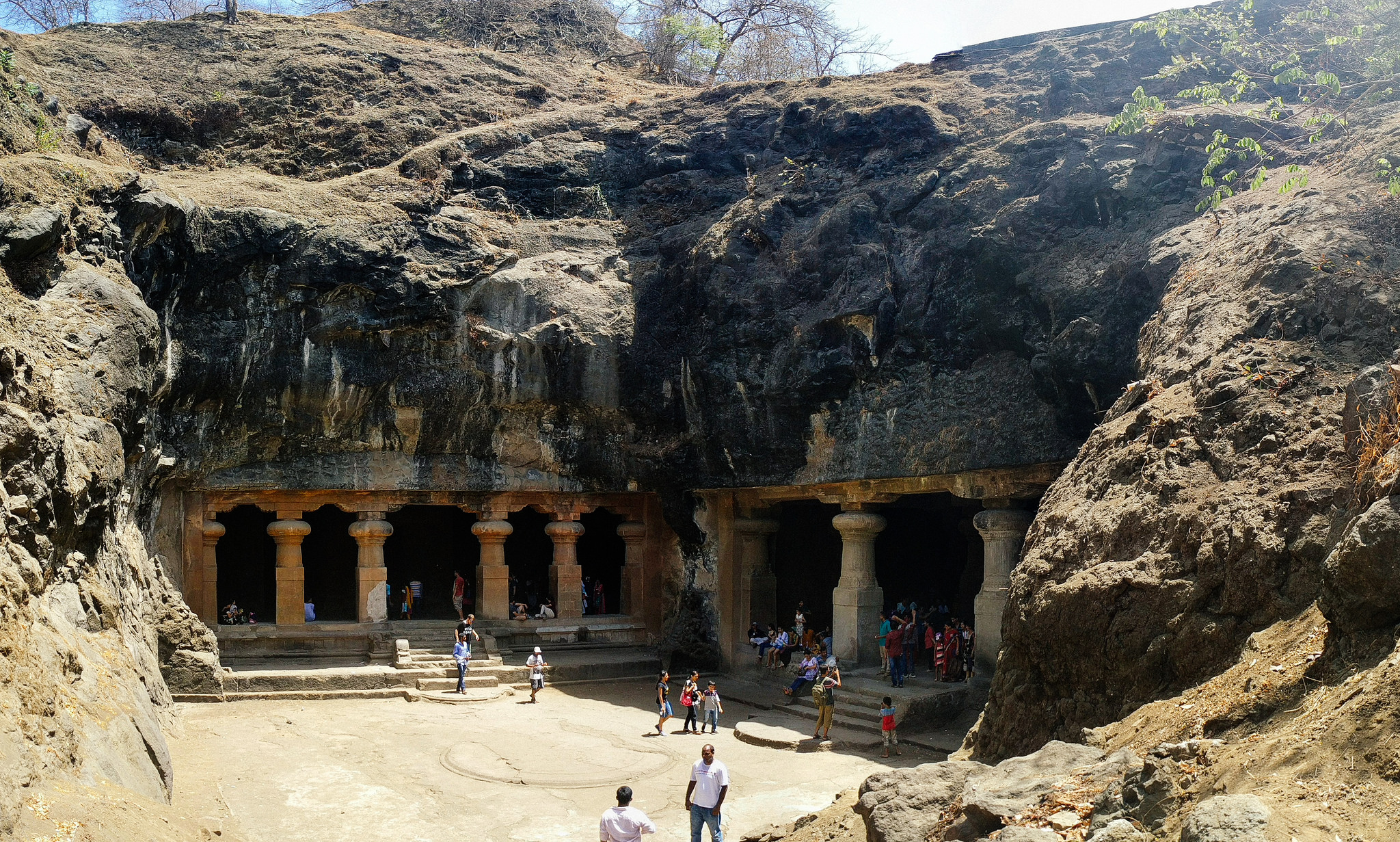
Built between 450-750 AD, a labyrinth of temples is cut into the basalt cliffs the most impressive, a Shiva-dedicated temple, is a latticework of courtyards, halls, pillars and shrines, with the highlight a 6 m tall statue of Sadhashiva – depicting a three-faced Shiva as the destroyer, creator and preserver of the universe (a god for everyone).
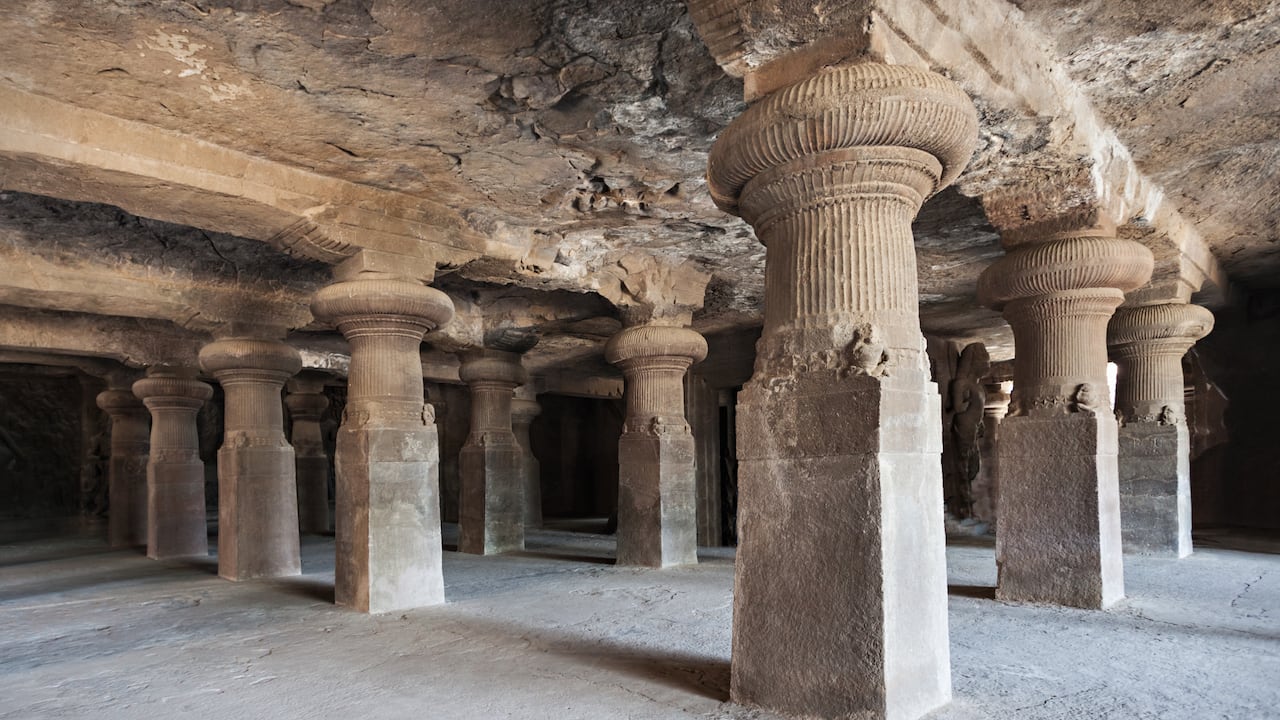
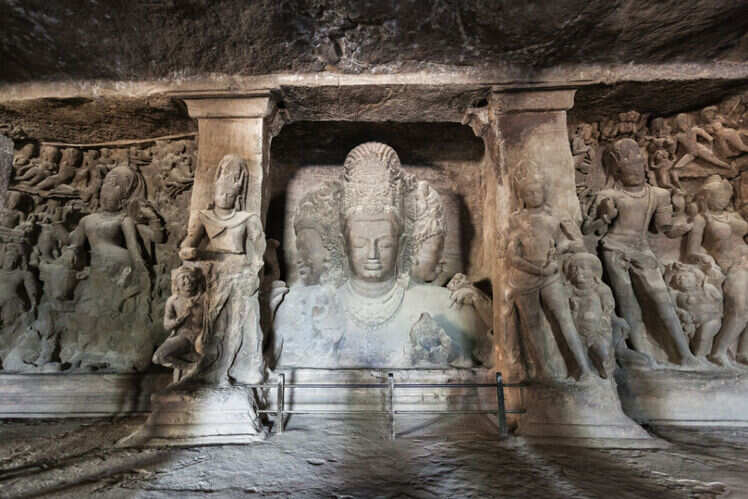
I did not visit Bollywood – the movies with their escapist formula – singing, dancing lovers conquer the forces keeping them apart – leave me uninterested.
MAHARASHTRA STATE
I then took a 6-hour day train NE to Aurangabad (pop 900,000, elevation 550 m) through several butte-like hills and then flat, dry country.
Bibi-qa-Maqbara, widely known as the Poor Man’s Taj, was built in 1679 as a mausoleum for Azam Khan’s mother and wife. With four minarets flanking a central onion-domed mausoleum, it bears a striking resemblance to the real Taj Mahal. However only the bottom and dome are marble, but it is still an impressive place.
Panchakki is a garden complex with a huge banyan tree and water wheel driven by water carried through earthen pipes from the river 6 km away. It was considered a marvel of engineering in its day.
Daulatabad Fort, 15 km from town, sits on a 200 m tall craggy outcrop surrounded by 5 km of high stone walls. The route up leads through an ingenious series of defences – spike studded doors to prevent elephant charges, and a pitch black, bat-infested spiralling tunnel. The vertical cliff walls are surrounded by an enormous moat dug into the basalt.
Kuladabad is a scruffy town containing the simple tomb of Aurangzeb but had added wonderfully carved lattice screens.
The main reason for coming to Aurangabad is the two sets of rock-cut temples nearby, both Unesco World Heritage sites. Ellora Caves are the epitome of ancient Indian rock-cut architecture, having been chipped out laboriously over 5 centuries.
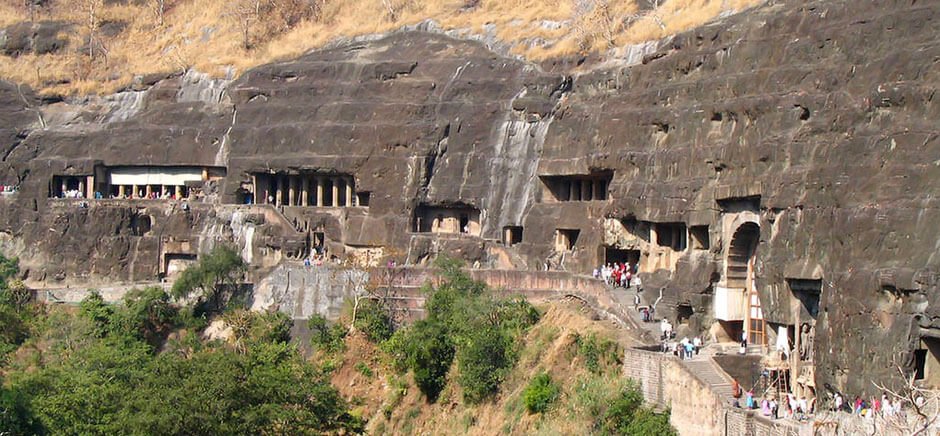
Used as monasteries, chapels and temples, the 34 caves along the 2 km long escarpment, are divided into 12 Buddhist (600-800 AD), 17 Hindu (600-900 AD), and 5 Jain (800-1000 AD) structures. The grandest is the Hindu Kailasa Temple (#16), the world’s largest monolithic sculpture, hewn top to bottom from a rocky slope with hammer and chisel by 7000 labourers over 150 years. 200.000 tons of rock were removed to create a structure twice the size of the Parthenon while taking care to leave the parts for sculpting. It is an engineering marvel with zero margin for error.
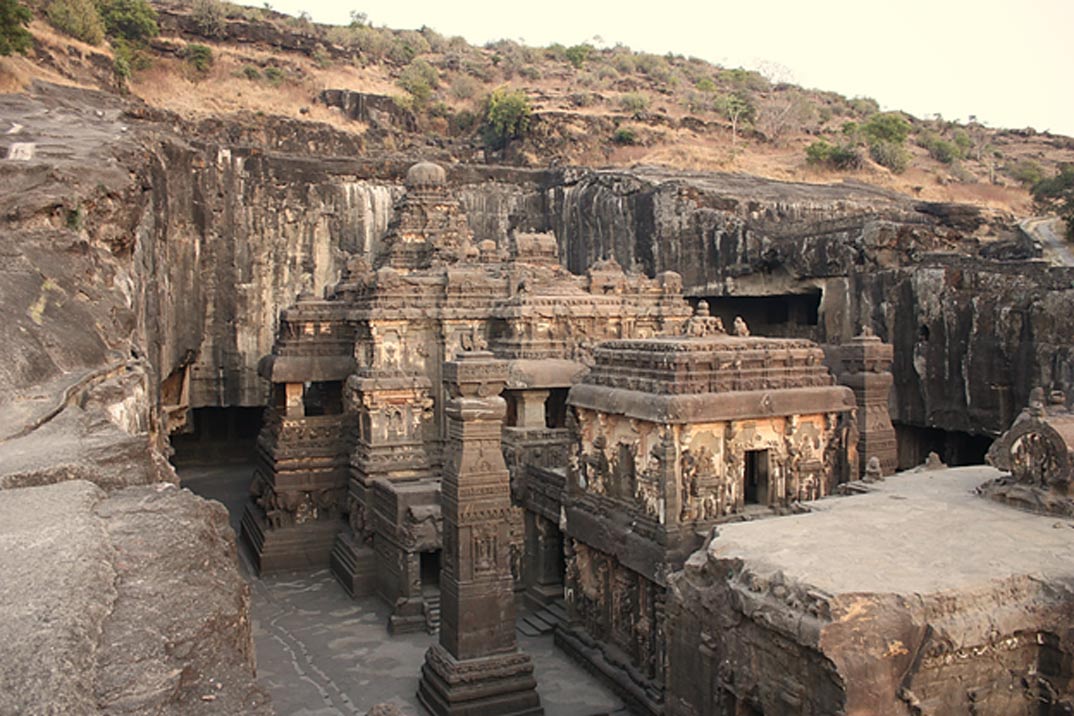
The Hindu caves were carved from the top down, so it was never necessary to use scaffolding. Inside is prodigious sculptural decoration including 10 giant panels depicting the different avatars of Vishnu. Like so many temples, there are many dank, bat urine-soaked corners. Two Buddhist caves are outstanding – Cave 5 is 18×36 m with stone benches for use as an assembly hall, and Cave 10 has a spectacular ribbed roof and an enormous teaching Buddha. Many caves are 2 or 3 stories tall and most have elaborate carved pillars supporting the roof.
Ajanta Caves were built between the 2nd and 6th centuries, abandoned soon after and not discovered until 1816 by a British hunting party. The caves are best known for their renowned frescoes, still remarkably preserved today. 105 km from Aurangabad, they are a full day trip with 3 hours of driving each way.

